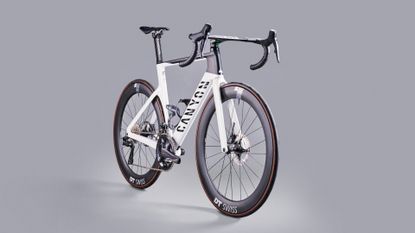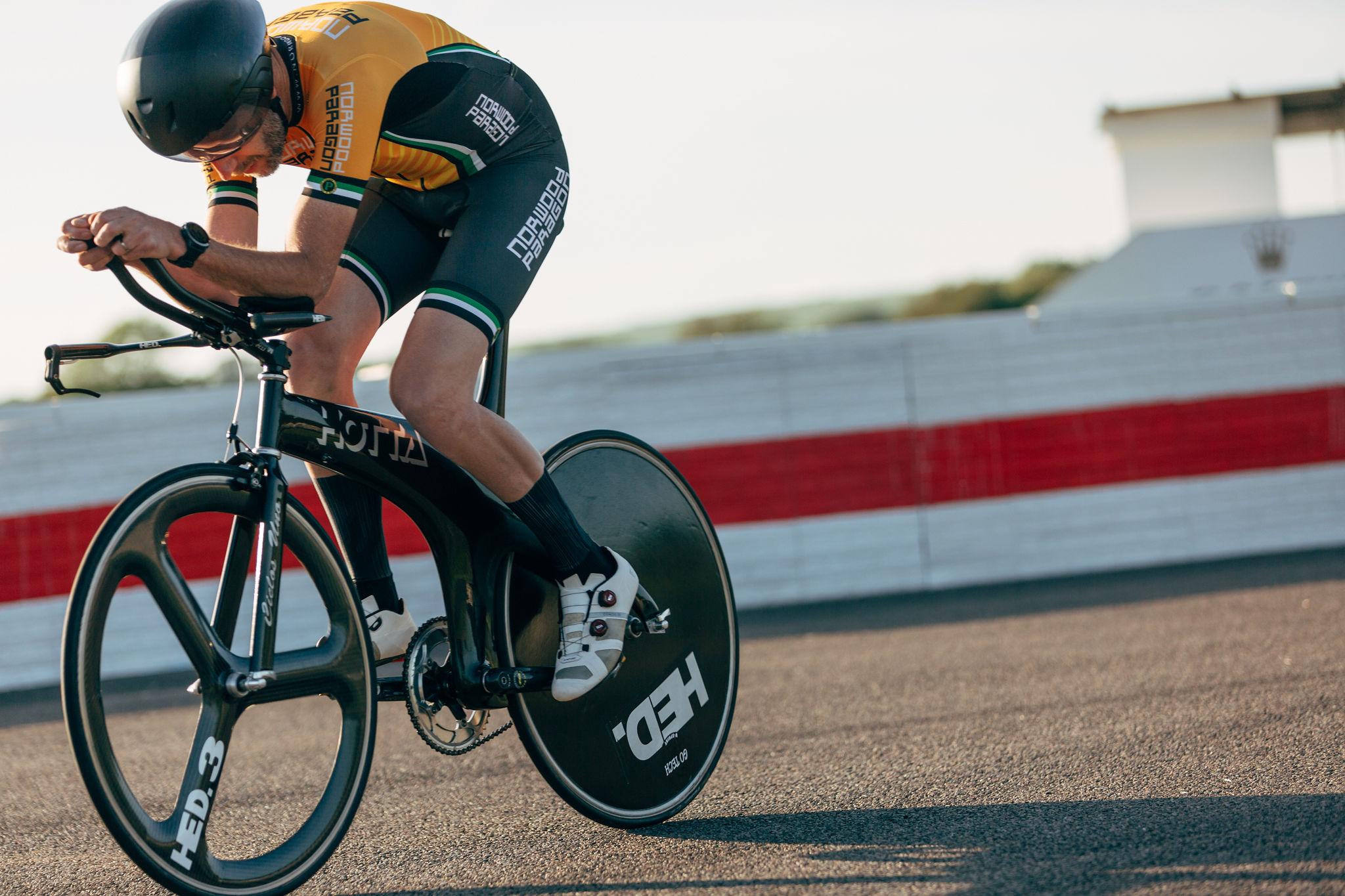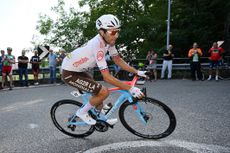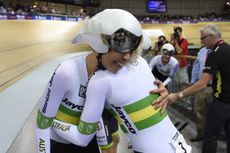Canyon Aeroad CF SLX 8 Di2 review - fast and keenly priced; a little chattery on rougher roads
The Aeroad packs a suite of neat features and is up there with the fastest aero bikes

The Canyon Aeroad stacks up well in terms of its speed, responsiveness, and weight (particularly for an aero bike). The rear-end comfort, courtesy of the 28mm tire and flexing seatpost, was much appreciated. As was the easy adjustability of the handlebar width and stack height - both possible without having to re-cabling, cutting the steerer tube or swapping in any components. However, the front end was a little chattery compared to other top models, plus sidewind gusts are a little more noticeable due to the shorter stem and deep section wheels. Overall, the Aeroad is a great bike - and its price is amongst the keenest .
-
+
Fast
-
+
Lightweight
-
+
Good value
-
+
Handy cockpit adjustability
-
-
Chattery front end
-
-
Narrow rims (by modern standards)
-
-
Extra bolts to think about with width-adjustable cockpit
You can trust Cycling Weekly.

This latest version of the Aeroad arrived at the end of 2020, taking over from the original model that was Canyon’s aero standard bearer for a full six years. And the standard it set was extremely high, both in terms of absolute performance and value for money compared to competitors.
So perhaps for that reason, simply making the new Aeroad faster and lighter wasn’t enough. Once those boxes were ticked, In order to keep it a step ahead of all the best aero bikes that had been updated, the German brand introduced an ingenious adjustable-width handlebar, which can also be height-adjusted by 1.5cm without without having to dismantle the whole thing and cut the steerer, and a clever seatpost that flexes inside the frame to improve comfort.
As we all know, both suffered high-profile teething problems in 2021 and were promptly redesigned. The Aeroad now is raced technical-problem-free in the WorldTour by Alpecin-Fenix and Movistar.
But is it still the aero bike to beat in 2023? We tested the Canyon Aeroad against eight other superbikes to crown our Race Bike of the Year grouptest. Read on to find out how it stacks up today...
Canyon Aeroad CF SLX 8: construction

The top Canyon Aeroad, raced by Mathieu Van der Poel et al, is the Aeroad CFR. This is made from a superior carbon-fibre compared with the CF SLX and CF SL and is therefore lighter (claimed frame weights 915g, 980g and 1,020g respectively).
The difference between the SLX and the SL is mainly down to spec: the SLX is electronic groupset only whereas the SL comes with mechanical groupsets and doesn’t have the CP0018 adjustable cockpit of the top two tiers.
So the Aeroad CF SLX 8 is almost slap bang in the middle of the expansive Aeroad range. There is, as Canyon points out, an Aeroad for everyone.
There are three CF SLX builds on offer and this one, the CF SLX 8 with Shimano Ultegra Di2 costs $5,699.00 / £6,199.00. While the SRAM Force AXS build comes in at $5,999.00 / £5,999.00, and the SRAM Rival AXS spec is $4,499.00 / £4,799.00
The latest Aeroad frame, developed with aerodynamics experts Swiss Side, has deeper tubing than the previous model, and is claimed to make the new bike 7.5 watts faster than before - and it looks like it.
Meanwhile the width-adjustable cockpit, credited with some of the watt-saving, is on paper a great idea with 40mm of adjustability, three width settings and collapsibility for travelling. But in practice, with rival bikes such as the new Trek Madone offering a range of sizes in its latest integrated cockpit to be swapped in at point of purchase, Canyon’s adjustable one with its Torx bolts underneath seems handy but clunky. Not only does the average rider never adjust their cockpit width but it adds two more bolts to potentially loosen or create stress risers.
Being able to adjust the bar height by 15mm without cutting the steerer is useful, but Canyon’s proprietary headset tool is required. It’s small, easily lost (I’m speaking from experience) my LBS didn’t have one and there was no obvious hack. So I had to order one from Germany. Once the tool arrived, however, the system worked very well.
I have only good things to say about Ultegra 8100 Di2, and yet more kudos for including a 4iiii crank-based power meter with this build.
But I’d like to see wider wheels in line with the Aeroad’s latest rivals. The DT Swiss ARC 1400 Dicut wheels have a 20mm internal rim width, narrow by modern standards. With a 25mm front tire (the rear comes with a 28mm) the narrow contact patch contributed towards a chattery front end.

The Aeroad has the same ‘Sport Pro’ geometry as the Ultimate, which is less aggressive - but still racy with a stack/reach ratio of 1.42 for the size M and a wheelbase of 989mm, and there are seven frame sizes for riders 158cm to 200cm+.
Canyon Aeroad CF SLX 8: the ride
This year I’ve been riding the Colnago V4Rs, the Cervelo S5, the Trek Madone and the Giant Propel more or less back to back, so have been able to compare the bikes easily - and I can say that the Aeroad matches all of them in terms of speed.
However, as I mentioned earlier, the front end lacks the refinement of the other bikes. The narrow front tire on a narrow rim is the most likely culprit for the transmission of vibrations from rough tarmac, but I also found the 100mm stem length, which was more like 95mm by my measurements, translated to excessive twitchiness, especially when the front wheel caught a gust - and the bike did seem prone to catching crosswinds, with the 62mm rim depth exaggerating this.

I wasn’t expecting the cockpit to be so flexible, yet it didn’t seem to damp the vibrations as you might expect; instead I couldn’t get rid of the thought that I was loosening the bolts while it was bending as I pulled on it during climbing.
As for the rear, although I didn't feel the seatpost actually flexing, I had no issues at all with rear end comfort, so I’m deducing it was doing its job - no complaints there. It features a redesigned sleeve bearing to fix the original issue with dirt ingress.

In summary, there’s no doubt this is a fast, super responsive, sharp-handling bike and the weight is impressive too, but it lacks the plushness and vibration damping of its rivals - which makes me wonder if it could potentially be even faster if the ride quality was smoother.
Canyon Aeroad CF SLX 8: value and conclusion

Priced at $5,699.00 / £6,199.00, the CF SLX 8 is considerably cheaper than most similarly specced WorldTour-level aero bikes. For example, the Trek Madone SLR 7, also specced with Ultegra Di2, costs $9,049.99 / £10,200.00. That’s even more than the Dura-Ace Di2 specced Canyon Aeroad CFR, the flagship model, which costs $8,999.00 / £9,249.00.
The Cervelo S5 with SRAM Force has an RRP of $9,000.00 / £9,599.00. The Colnago of course is stratospherically expensive.
However, the Ultegra Di2-equipped Giant Propel has an RRP of $8,000.00 / £5,999.00 (though it doesn’t have a power meter) and the Rival AXS-equipped Propel ($5,200.00 / £5,499.00) won the ‘best value’ category in our Race Bike of the Year grouptest. Personally I slightly preferred the Propel’s more planted, controlled ride feel, though the SRAM Rival AXS-equipped Propel was almost a kilo heavier.
Canyon Aeroad CF SLX 8: spec
- Frame: Canyon Aeroad CF SLX
- Fork: Canyon FK0060 CF
- Groupset: Shimano Ultegra 8100 Di2 with 4iiii Precision power meter
- Wheels: DT Swiss ARC 1400 Dicut
- Tires: Continental Grand Prix 5000 25/28
- Bar/stem: Canyon CP0018 Aerocockpit
- Seatpost: Canyon SP0046 Aero Seatpost
- Saddle: Selle Italia SLR Boost Superflow S manganese

Thank you for reading 20 articles this month* Join now for unlimited access
Enjoy your first month for just £1 / $1 / €1
*Read 5 free articles per month without a subscription

Join now for unlimited access
Try first month for just £1 / $1 / €1
Get The Leadout Newsletter
The latest race content, interviews, features, reviews and expert buying guides, direct to your inbox!
Simon Smythe is a hugely experienced cycling tech writer, who has been writing for Cycling Weekly since 2003. Until recently he was our senior tech writer. In his cycling career Simon has mostly focused on time trialling with a national medal, a few open wins and his club's 30-mile record in his palmares. These days he spends most of his time testing road bikes, or on a tandem doing the school run with his younger son.
-
 Larry Warbasse claims what could be the world's toughest Strava KOM
Larry Warbasse claims what could be the world's toughest Strava KOMThe 89.5km Mauna Kea climb in Hawaii rises from sea-level to 4,214 metres with steep gravel sections on the way
By James Shrubsall Published
-
 ‘We need to honour her memory’ - Melissa Hoskins’ parents pay tribute after Olympian’s tragic death
‘We need to honour her memory’ - Melissa Hoskins’ parents pay tribute after Olympian’s tragic deathFamily and former teammates mourn loss of Australian cyclist
By Tom Davidson Published
-
 A break up letter to... Strava
A break up letter to... StravaIt's not you, it's me. But, some of it is you.
By Michelle Arthurs-Brennan Published


